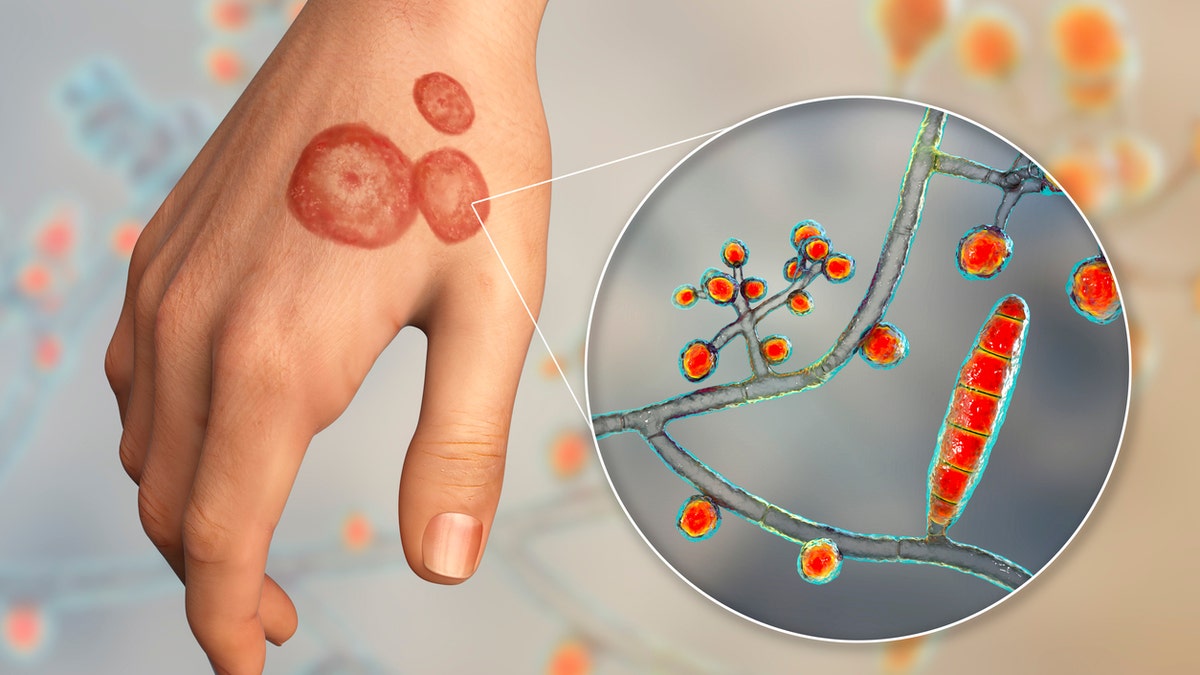CDC on guard over deadly fungus spreading throughout the US
Fox News medical contributor Dr. Marc Siegel unpacks a deadly fungus spreading throughout the U.S.
Two cases of a common fungal infection known as tinea, or ringworm, failed to respond to standard treatment due to a recently emerged fungus in the United States, according to a recent Centers for Disease Control and Prevention (CDC) report.
"Tinea is a common, highly contagious, superficial infection of the skin, hair or nails caused by dermatophyte molds," the CDC said in the report.
A new fungal species, known as Trichophyton indotineae, has resulted in a severe epidemic of drug-resistant ringworm in South Asia in the past decade due to the misuse and overuse of topical antifungal treatment and corticosteroids, the report also said.
DRUG-RESISTANT RINGWORM DETECTED IN US FOR FIRST TIME, CDC SAYS
Infections caused by this drug-resistant fungus have also been reported in Europe and Canada, but this is the first time they have been reported in the U.S. — specifically in New York City.
Why is this infection called ringworm?
The name can be confusing because the infection is caused by a fungus, not a worm.
"Ringworm is so named because it usually causes a circular rash that is red and itchy [and] caused by a fungus," Dr. Aaron Glatt, chief of infectious diseases at Mount Sinai South Nassau Hospital on Long Island, New York, told Fox News Digital.

Two cases of a common fungal infection known as tinea, or ringworm, failed to respond to standard treatment due to a recently emerged fungus in the United States. (iStock)
The red outline of the rash resembles how a typical worm appears when both its ends meet.
"It is from a group of fungi, known as dermatophytes, [which] can attack any part of the body," Glatt said.
He noted that many different types of fungi can cause ringworm, including Trichophyton, Microsporum and Epidermophyton.
TICK BITES AND LYME DISEASE: WHAT TO DO IF A TICK BITES YOU OR YOUR PET
Medical professionals refer to the condition as "tinea" followed by the specific body part that’s involved.
"Its proper medical name is tinea, and when it is on the body, it is called tinea corporis," Glatt explained.
"It is the cause of athlete’s foot, or tinea pedis, when it attacks the feet and toes, and ‘jock itch,’ or tinea cruris, when it attacks the groin."
Recognizing the symptoms of ringworm
The symptoms can vary depending on the specific body part that’s infected, but ringworm generally causes an itchy, ring-shaped rash with a scaly appearance.
"Symptoms typically appear between four and 14 days after the skin comes in contact with the fungi that cause ringworm," the CDC noted.

Many different types of fungi can cause ringworm, including Trichophyton, Microsporum and Epidermophyton. (iStock)
For ringworm of the scalp, also called tinea capitis — which commonly occurs in children — a telltale sign is a "scaly, itchy, red, circular bald spot," per the CDC.
"The bald spot can grow in size, and multiple spots might develop if the infection spreads," the CDC added.
"The fungi that cause this infection can live on skin, surfaces and on household items such as clothing, towels and bedding."
Ringworm of the groin, or "jock itch," often appears as a red, scaly, itchy rash on the inner thighs.
Ringworm on the feet, or athlete’s foot, often appears as "red, swollen, peeling, itchy skin" between the toes, especially between the fourth and fifth toe, according to the CDC.
How does ringworm spread?
"The fungi that cause this infection can live on skin, surfaces and on household items such as clothing, towels and bedding," the CDC noted on its website.
It can spread from person to person, such as when touching the rash of someone with ringworm, or from animal to person, such as sleeping with a dog infected with ringworm.

Ringworm can spread in damp environments, such as locker room floors or swimming pools. The CDC advises against walking barefoot in locker rooms or public showers. (iStock)
Ringworm can also spread in damp environments, such as locker room floors or swimming pools.
The CDC advises against sharing household items such as clothing, towels or combs with those infected with ringworm. It also advises that people not walk barefoot in locker rooms or public showers.
Treatment options
"Usually, these infections are not life-threatening and can be treated with various over-the-counter creams or lotions," Glatt noted.
"Serious infection, however, may require prescription antifungal medications."
POTENTIALLY DEADLY, DRUG-RESISTANT FUNGUS SPREADING RAPIDLY IN US
In the two drug-resistant cases in New York City that were recently reported to the CDC, one involved a 28-year-old pregnant woman who developed ringworm on her neck, belly, pubic region and buttocks.
The other case was a 47-year-old woman without significant medical problems; she developed an itchy rash typical of ringworm on her thighs and buttocks.
The 47-year-old woman initially developed the rash while in Bangladesh, but the pregnant patient reported no international travel — "suggesting potential local U.S. transmission of T. indotineae," per the CDC.
CLICK HERE TO SIGN UP FOR OUR HEALTH NEWSLETTER
Oral terbinafine, an antifungal medication, failed to treat either of the patients' severe ringworm cases.
The CDC encourages health care providers "to minimize the misuse and overuse of prescribed and over-the-counter antifungal drugs and corticosteroids."
CLICK HERE TO GET THE FOX NEWS APP
The agency also said that patients should be educated about ways to prevent the spread of fungi that cause ringworm.









































